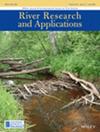二维水动力模型分辨率对不同河道形式下驯养科霍鲑栖息地估计值的影响
IF 1.9
4区 环境科学与生态学
Q4 ENVIRONMENTAL SCIENCES
引用次数: 0
摘要
估算水量分配决策对鱼类种群和栖息地可用性的影响是环境流量评估的重要组成部分,尤其是在水资源有限的地方。二维流体动力学模型(2DHM)通常与生物模型相结合,用于估算鱼类栖息地的质量、面积和在一定范围内的拟议流量。资源管理者越来越依赖于具有粗模型分辨率的景观尺度模型域,以维持可行的计算负荷,但如果模型的网格元素尺寸超过了与生物相关的空间尺度,则可能会影响栖息地的估算。我们研究了二维水文模型分辨率的粗化如何影响鲑鱼(Oncorhynchus kisutch)鱼苗栖息地的估计面积和空间分布。我们使用一种插值方案,将高分辨率(0.25 m2)二维水文模型中的网格元素放大,以量化和可视化二维水文模型分辨率对两种截然不同的河道形态和广泛的水流范围内鲑鱼苗栖息地估计值的影响。在复杂河道类型中,以越来越粗的分辨率估算库荷鲑鱼苗栖息地会导致加权可用栖息地面积(WUA)在几种水流情况下减少 20%-50%,但不会影响封闭的水槽型河道的估算结果。此外,当分辨率变粗时,在给定的溪流中,流量与栖息地面积的关系并不一致。复杂河道类型的优质栖息地面积比封闭河道类型多出近 500%,同时,在被定义为最适合饲养库荷鲑鱼苗的区域,随着水流增大,栖息地面积的差异也会增大。考虑到复杂河道类型包含库荷鲑鱼苗的重要栖息地,本研究表明,粗糙的 2DHM 分辨率可能会将重要的湿润边缘和河道外栖息地排除在环境流量评估之外。本文章由计算机程序翻译,如有差异,请以英文原文为准。
Effects of 2D hydrodynamic model resolution on habitat estimates for rearing Coho Salmon in contrasting channel forms
Estimating the impacts of water allocation decisions on fish populations and habitat availability is an important part of environmental flow assessments, especially in locations where water resources are limited. Two‐dimensional hydrodynamic models (2DHMs) are commonly coupled with biological models to estimate fish habitat quality, area, and capacity across a range of proposed streamflows. Increasingly, resource managers are relying on landscape‐scale model domains with coarse model resolutions to maintain feasible computational loads, but this may affect habitat estimates if the mesh element size of the model exceeds the spatial scale relevant to the organism. We investigated how coarsening the resolution of a 2DHM influences the area and spatial distribution of estimated Coho Salmon (Oncorhynchus kisutch ) fry habitats. We used an interpolation scheme that upscaled mesh elements from a high‐resolution (0.25 m2 ) 2DHM to quantify and visualize the effects of 2DHM resolution on estimates of Coho Salmon fry habitat for two contrasting channel morphologies and across a broad range of streamflows. Estimates of Coho Salmon fry habitat at increasingly coarser resolutions led to 20%–50% reductions in weighted usable habitat area (WUA) across several streamflow scenarios for a complex channel type, but did not impact estimates in a confined, flume‐like channel. Additionally, flow‐to‐habitat area relationships were not congruent at a given streamflow when resolution coarsened. Along with almost 500% more high‐quality habitat area estimated in the complex channel type over the confined, discrepancies in habitat area increased with higher flows in areas defined as optimal for rearing Coho Salmon fry. Considering that complex channel types contain critical habitat for Coho Salmon fry, this study suggests coarse 2DHM resolutions may exclude important wetted edge and off‐channel habitats from environmental flow assessments.
求助全文
通过发布文献求助,成功后即可免费获取论文全文。
去求助
来源期刊

River Research and Applications
环境科学-环境科学
CiteScore
4.60
自引率
9.10%
发文量
158
审稿时长
6 months
期刊介绍:
River Research and Applications , previously published as Regulated Rivers: Research and Management (1987-2001), is an international journal dedicated to the promotion of basic and applied scientific research on rivers. The journal publishes original scientific and technical papers on biological, ecological, geomorphological, hydrological, engineering and geographical aspects related to rivers in both the developed and developing world. Papers showing how basic studies and new science can be of use in applied problems associated with river management, regulation and restoration are encouraged as is interdisciplinary research concerned directly or indirectly with river management problems.
 求助内容:
求助内容: 应助结果提醒方式:
应助结果提醒方式:


